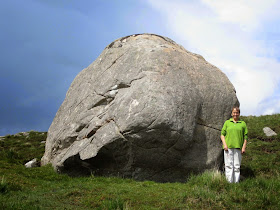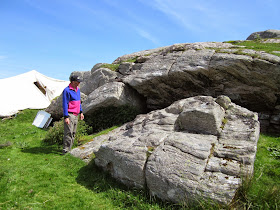Map of classic "knock and lochan" topography just to the south of Callanish, Isle of Lewis. This map, from Google Earth, just shows land (the knocks or knolls) and the lochans (the small lakes). You can pick uop a rough rectilinear pattern, attributable to the fracture pattern in the Lewisian Gneiss bedrock
Part of the same area, from the satellite image. The lochans stand out very clearly, and colours have been enhanced so that the vegetated peaty patches show up as light-coloured areas and the bare (scoured) bedrock shows up with the brown colouring.
For those who are interested in the idea that the rocky ridges used for the Callanish stone settings are special in some way, and can be referred to as "crag and tail" features, I reproduce below an interesting description of the glacial landscape features of Harris and Lewis. As I have mentioned before, there is nothing special about the ridges used for the stone settings, and indeed they are less prominent than many other ridges in this landscape -- this is really a textbook example of knock and lochan topography, with Callanish located on the coastal edge of this deeply scoured landscape.
See also:
http://www.landforms.eu/shetland/Knock%20and%20lochan.htm
The Geodiversity of the Isle of Harris:
Statement of Significance and Identification of Opportunities
Geology and Landscape (Northern Britain) Programme Report CR/07/032N
http://nora.nerc.ac.uk/7490/
2 The Geological History of the Isle of Harris (extract)
Although the rocks that form the Isle of Harris have not changed since 55 million years ago, the shape of the landscape has undergone considerable modification over the last 2.6 million years. During this time northern Europe has been subjected to a series of climatic cycles, represented by alternating glacial and interglacial conditions. The glacial episodes are characterised by cold, unstable climate, and growth of large ice-sheets in the high and mid latitudes. In contrast, interglacials (such as the current Holocene period which began approximately 11,500 years ago) experience a warmer, more stable climate, with more restricted ice cover.
The first evidence for Harris being ice-covered comes from glacial sediments offshore, demonstrating that an extensive ice sheet covered Scotland about 440,000 years ago, terminating at the margin of the continental shelf. At this time, it is likely that there was full ice cover over Harris and the rest of the Western Isles. It is not clear whether Harris was overwhelmed by ice flowing from the Scottish mainland or if it supported an independent ice cap during this early glaciation. It has been suggested that the numerous sea-filled channels of the Western Isles, such as the Sound of Harris, represent glacially carved through-valleys from a period of lower sea- level. Glacially transported rocks originating from the Scottish mainland have been found, as ‘erratics’, in the northern and southern extremities of the Western Isles, lending some support to this idea.
The most recent major glaciation in Scotland (known as the Main Late Devensian glaciation) reached its maximum extent about 22,000 years ago. At this time the Western Isles supported an independent ice cap with a central dome forming over the mountains of North Harris. Ice flowed outwards from the dome (which reached a maximum surface altitude of about 700 metres) down towards the coast moulding and smoothing the lower-lying rock. Ice flowing east from Harris combined with mainland glaciers to feed a large, fast-flowing ice-stream in the Minch (much like the ice-streams operating today in Antarctica).
A period of warming had melted much of the ice cover over Harris by about 14,000 years ago, but some glaciers may have persisted in favourable locations in North Harris. Smaller valley and corrie glaciers probably re-developed in the mountains of North Harris during a subsequent,
short-lived cold spell 12,500 to 11,500 years ago, known as the Loch Lomond Stadial. During this period low temperatures would have promoted freeze-thaw activity on exposed ground, shattering rocks and giving rise to downslope creep of soil and scree.
At the end of the cold spell, as the final remnants of ice melted away, Harris would have supported open grassland vegetation, similar to some parts of northern Canada today. However, as temperatures warmed and soils matured, birch, hazel and oak migrated into the Western Isles, becoming established by about 8,000 years ago. Shortly afterwards, woodland began to decline and was replaced by acid grass and heathland communities. This decline may have been associated with the climate becoming slightly cooler and wetter some 6000 years ago. The occurrence of microscopic charcoal of the same age in peat bog records from South Uist, however, suggests that deforestation by Mesolithic Man may also have contributed.
3 Geology and Landscape of the Isle of Harris
Most descriptions of the Isle of Harris use the words ‘rugged’, ‘rocky’ and ‘mountainous’ to describe the east coast and the interior of the island, and contrast these with the machair and the miles of white sand beaches along the west coast. This landscape is truly a product of the underlying geology. The Lewisian gneisses are hard and unyielding rocks which are not easily eroded, and thus most of the island is very rugged, with abundant rock outcrops. Parts of the interior of Harris are characterised by ‘cnoc-and-lochan’ topography, with low rocky knolls separated by hollows, and this type of landscape is also typical of Lewisian gneiss terrain on the mainland.
Because most of North Harris is made up of similar gneisses, variation in the type of landscape across this part of the island is relatively limited. This contrasts with the clear landscape control exerted by the different rocks of South Harris Complex. The peak of Roineabhal is largely made up of anorthosite – a rock almost entirely composed of plagioclase feldspar - that weathers to a pale grey to white colour, and stands out when compared to the darker-coloured gneisses across the rest of the island. The diorites and tonalites form the more rounded hills around Bleabhal, whilst the metamorphosed sedimentary rocks generally underlie lower ground. The Langavat Belt in particular forms a clear zone of weakness, which has been eroded to create a valley that stretches across the island. The variation of the bedrock geology across the island also manifests itself in smaller-scale landscape features: well-known examples of this are the pegmatite sheet on Ceapabhal, which stands out as a distinct ridge of rock running across the slope above Tràigh an Taobh Tuath; or the metamorphosed limestones around St Clement’s Church at Roghadal.
The faults that developed prior to the opening of the North Atlantic form zones that can be easily eroded; the rocks are relatively soft after being ground down as they moved against each other along the fault. These faults underlie some of the most distinctive valleys of Harris, including Gleann Crabhadail and the glens leading into Loch Stocinis. These valleys probably began to form many millions of years ago, and have then been gouged out to their present depths by the movements of glaciers.
The mountainous terrain of north Harris was an ice cap accumulation centre during the last major glaciation. Higher summits such as An Cliseam, Uisgneabhal Mór and Oireabhal would have protruded above the ice surface, like nunataks do today in Greenland. These exposed peaks were subjected to severe frost-shattering, while terrain lying beneath the ice was smoothed and moulded. Examples of the boundaries between these two types of terrain, called ‘trimlines’, can be clearly seen on the northwest spur of Uisgneabhal Mór at about 580 metres and the southeast spur of Tiorga Mór at about 500 metres.
Vigorous glacial erosion affected the lower lying terrain in south Harris, creating the ‘cnoc-and- lochan’ landscape. Here, rock hillocks have been smoothed by ice, generating ‘whaleback’ landforms, with the intervening depressions becoming water-filled following ice retreat. The ‘cnoc-and-lochan’ topography is well developed on the south-east of the island and can be viewed from the coastal road between Aird Mhighe and Roghadal. In the mountainous areas of North Harris, glacial erosion was concentrated along existing valleys. Ridges at the margins of these valleys were eroded by the glaciers to form truncated spurs; the most well-known example is Sròn Uladal, reputed to have the highest overhanging cliff in Britain. Rockfalls, following the retreat of the ice, have steepened this cliff to its present shape.
Numerous boulder-strewn mounds and ridges can be seen in the corries and glaciated valleys of North Harris. These ridges formed when sediment was deposited at the margins of glaciers as moraines, probably during the short-lived Loch Lomond Stadial 12,500 to 11,500 years ago. The moraines are particularly well developed around the southern end of Loch Langabhat and around Loch Bhoisimid, and are comparable in shape and size to those forming at the margins of some Icelandic glaciers today. In Glen Skeaudale, some of these moraine ridges have streamlined features, known as flutes, superimposed on their up-valley side. As flutes form underneath glaciers, their presence suggests that the moraines were partly overridden by small glacier re-advances.
One of the key elements of the Harris landscape is the machair of the west coast. The geology of the island has played its part in the formation of the machair, because the lack of easily eroded rock means that only small amounts of sediment are carried by rivers flowing to the coast, and thus the sands of the west coast have a high percentage of offshore-derived shelly material. This sand composition is an integral part of the machair system. Machair systems form a gently sloping coastal plain, with coastal sand dunes backed by grassy plains that support a wide variety of wild flowers. Bogs and lochans, which are typically associated with these machair areas, provide habitats for a wide range of birds and other animals.
In many areas, the machair is slowly being eroded, due to a combination of factors that include less sediment supply from offshore, increased storminess leading to more wave erosion, and, in some places, sand removal by humans. However, the machair can still be enjoyed at many places on Harris, including Taobh Tuath, Horgabost and Seilebost.




















































